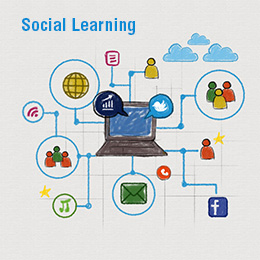
What Is the Learner-centered Design Approach in Learning?
A learner-centered approach in L&D and training focuses on the needs, abilities, and learning styles of the learner. This approach shifts the emphasis from traditional instructor-led methodologies to a more personalized and active learning process.
Effective learning, quite simply, happens as a result of the learning that a learner is looking for. The learner finds, accesses, and consumes, understands, and then eagerly applies it to the workplace. A cookie-cutter design approach won’t produce effective learning, and neither will design created entirely in studios and learning labs cut it! Crafting impactful learning solutions necessitates adhering to a learner-centered design approach.
So, what does that entail? It requires that L&D teams consciously put the learner at the center of everything they do when producing learning content:
- First, understand who your learners are and what their learning needs are.
- Then, customize your learning content to meet those expectations.
- Finally, tailor your delivery, including the choice of the most appropriate learning technology, to fit their individual learning preferences.
Embrace this learner-centered design philosophy, and consistently generate effective learning experiences that align with your objectives! Learners will not only actively seek your learning solutions but will also enjoy the learning experiences you deliver. They will demonstrate their satisfaction through real workplace performance improvements. It also helps build resilient, high-performing individuals and teams with a deeper engagement with the organization.
Key aspects of a learner-centered approach include:
- Personalization: Tailoring learning experiences to individual learner profiles, preferences, and needs.
- Active Learning: Encouraging learners to actively participate in their learning journey through interactive and hands-on activities.
- Feedback and Adaptation: Continuously gathering feedback from learners to adapt and improve the learning process.
- Collaborative Learning: Facilitating opportunities for learners to collaborate and learn from each other.
- Empowerment: Empowering learners to take control of their learning, fostering self-directed learning skills.
- Flexibility: Offering flexible learning paths and options to accommodate different learning speeds and styles.
This approach is designed to make learning more engaging, relevant, and effective by centering the process around the learner’s specific needs and goals.
Why Adopt a Learner-centered Approach?
Adopting a learner-centered approach offers several benefits that significantly enhance the effectiveness of educational programs:
- Enhanced Engagement: By focusing on the learner’s interests and needs, this approach fosters greater engagement and motivation.
- Improved Learning Outcomes: Learners are more likely to retain and understand material when it aligns with their learning styles and goals.
- Adaptability and Flexibility: Embracing this approach provides the flexibility needed in content and teaching methods, accommodating diverse learning speeds and styles.
- Empowers Learners: It encourages self-directed learning and critical thinking, empowering learners to take control of their educational journey.
- Increased Satisfaction and Retention: Learner-centered programs often lead to higher satisfaction rates, which in turn can lead to better retention rates in educational settings.
This approach is beneficial not just for learners but also for educational institutions and organizations, as it leads to more effective and satisfying learning experiences.
What is Learner-centered Design Theory?
Learner-centered Design Theory emphasizes creating educational environments that cater to the needs and preferences of learners. It involves understanding the learners’ background, interests, and learning styles to design effective and engaging educational experiences. The theory posits that when learners are at the center of the design process, it leads to more meaningful and impactful learning outcomes. This approach contrasts with traditional, one-size-fits-all education methods, advocating for a more personalized and adaptive learning experience.
What is Learner-Centered Design?
Learner-Centered Design (LCD) is an educational framework that prioritizes the unique needs, skills, and interests of learners in the creation of learning experiences. This approach is characterized by:
- User-Centric Development: Designing learning experiences specifically tailored to the end user, considering their background, preferences, and learning objectives.
- Interactive and Engaging Content: Creating content that actively involves the learner, making the learning process more engaging and interactive.
- Feedback Mechanisms: Implementing continuous feedback loops to adapt and improve the learning experience based on learner input and performance.
- Flexibility in Learning Paths: Allowing learners to choose their learning paths and pace, accommodating different learning styles and speeds.
The objective of Learner-Centered Design is to forge learning experiences that are not just effective but also enjoyable and personalized, with the learner positioned at the core of the design process.
Are Learner-centered Design and Human-centered Design the Same?
Learner-centered Design and Human-centered Design, while sharing similarities in their user-focused approaches, are not the same. Learner-centered Design specifically targets the unique needs and preferences of learners in educational contexts, emphasizing personalized, effective learning experiences. Human-centered Design, on the other hand, is a broader concept applied across various fields, focusing on designing products, services, or solutions that are intuitive and responsive to all users’ needs. While both prioritize the end-user’s experience, their scope and application contexts differ.
What is Learner-centered Design Principles?
The principles of learner-centered design are centered around tailoring educational experiences to meet the unique needs and preferences of each learner. Key principles include:
- Personalization: Tailoring learning experiences to individual needs and preferences.
- Active Participation: Encouraging learners to engage actively with the material.
- Feedback and Adaptation: Using feedback to continuously improve the learning experience.
- Collaborative Learning: Promoting interaction and collaboration among learners.
- Empowerment: Giving learners control over their learning process.
- Flexibility: Offering varied learning paths to accommodate different learning styles.
These principles aim to make learning more effective, engaging, and relevant by centering the process around the learner’s specific needs and goals.
Why Should You Incorporate a Learner-centered Design Approach for Your L&D Strategy?
With many potential L&D strategies to choose from, why should L&D professionals adopt a learner-centered design approach? There are two compelling reasons that a design approach, which keeps learners at its center, is critical.
Firstly, there’s the employee perspective. Unless your employees – who are the targeted learners – “drive” the process, it’ll be a challenge to produce a design that delivers them the learning experience they crave: Focusing on the LEARNER, as the center of the solution, will also help create a more humanist environment at the workplace.
The employee experience challenge and its implications:
- Employee engagement: Workplaces with a higher employee engagement quotient typically represent better performing organizations. Learning design, which does not inspire learner engagement, ultimately translates into disengagement in other spheres of the workforce – performance, innovation, productivity, and competitiveness.
- Employee retention: IBM’s research shows that addressing learner-needed training increases retention by 62%. Employees gravitate toward employers who value learning and who actively encourage them to participate in professional development. In the absence of a learner-centered design approach, employees, who do attempt to embrace corporate learning opportunities, may quickly feel dissatisfied and disillusioned with the learning experience they encounter, and the quality and focus of their training. This may hasten their exit from the company.
And secondly, there’s the business/org-level and the design team’s perspective to consider.
Why Is Learner-centricity Important While Designing Corporate L&D Programs?
The Org perspective: From the employer’s perspective, any learning that’s designed with learners as the central focus can impact org-level competency by building a more motivated workforce. Motivated employees exhibit greater loyalty, reducing the frequency of turnover and subsequently lowering organizational hiring costs through enhanced retention.
The L&D team’s perspective: When it comes to responding to learning, each learner, within every organization, is unique. From the L&D teams’ perspective, therefore, if they aim to produce effective learning content, then they’ll need to put the learners’ needs into focus. This will allow them to create personalized learning journeys and unique learning experiences.
What Are the Benefits of Adopting a Learner-centered Design Approach?
There are several reasons to embrace a learner-centered design approach:
- Connect with learners to drive deeper engagement: Learning that centers around learner needs helps better connect with learners and prompts deeper engagement with the content.
- Drive meaningful behavior change: Because the learning “speaks” to specific learning requirements and skills gaps, it’s more likely to precipitate desired behavioral changes among employees who undertake such learning.
- Motivate and drive performance by creating engaging experiences: Greater employee engagement with training produces more motivated learners. This results in greater transference of learning into the workplace, which translates to performance gains.
- Humanize the learning experience: Learner-centered design moves away from “cookie cutter” learning and produces more personalized learning experiences. This “human touch” to learning also spurs learner engagement and results in better learning outcomes.
- Create a high ROI and ROE (return on expectation): Because employees are more likely (62%) to remain with the company – thanks to the learner-specific training they receive, the learner-centered design reduces employee retraining costs that follow resignations. It also eliminates employee replacement costs, which can surpass salary costs by over 200%. Both metrics translate into higher ROI for the organization. A learner-centric design also helps define a clear set of learning expectations and outcomes for learners and L&D teams. In so doing, it helps learning leaders better manage, measure, and evaluate their learning ROE across the company.
- Better org-wide learning metrics: With learning centered around the employee’s skills gaps and learning needs, learners are more likely to sign up for new courses. And because it (learner-centric learning) addresses specific workplace situations for the employee, they’re more likely to complete the entire prescribed learning, resulting in fewer dropouts. There’ll also be fewer requirements for course repeats, lower remedial training, and greater learning retention – all of which are positive learning measurement metrics.
3-Step Process to Implement a Learner-centered Design Approach for Your Learning Programs
(Inspired by IDEO’s 3 phases for human-centered design)
- Research and Analysis: The initial building block of learner-centered design is extensive research and analysis. To do that, L&D professionals must immerse themselves into their target learners’ lives and understand what their learning goals and needs are. Some of the tactics and techniques used in this phase include:
- Gaining a deep understanding, through market research and learner analysis, of what drives and motivates the modern learner.
- Making sure organizational goals and objectives align with those of the learner.
- Conducting an in-depth Learning Needs Analysis (LNA) to document specific learning needs, challenges, motivations, opportunities, and preferences, so that L&D teams address them in the program definition and design phase.
- It helps to review past program performance, learn from what went right and what didn’t go well, and address them during the design and development phase.
- While leaning on the expertise of subject matter experts (SMEs) is always advised, learners and L&D team members who participated in previous iterations of the course, or who worked on designing and developing prior programs, are an additional source of guidance and inspiration to tap into.
- Define: This is where you leverage everything you’ve learned, from the Research & Analysis phase, and use learner-centered design to create prototype solutions to apply to the learning opportunities you’ve identified.
- Build learner personas: Use insights from your audience analysis to produce hypothetical learner profiles, called Learner Personas, to give you a better understanding of who your target learners are and what their learning needs are.
- Map learner career paths to learning journeys: Since this is about creating learner-centric learning experiences, here’s where you map learners’ career aspirations to their learning needs. This allows L&D teams to create highly effective personalized learning journeys so learners can achieve those career goals and objectives.
- Identify eLearning strategies, delivery strategies, and modalities: The best learning outcomes occur when eLearning is available how learners want to learn and in the way and format they’re looking for. Here’s where eLearning designers identify L&D delivery strategies and learner-centric eLearning modalities and interventions that appeal to their learner audiences.
- Identify metrics and KPIs: The success of learning can be accurately gauged when interventions target metrics and KPIs that are specific, measurable, and achievable. Learning leaders must define these metrics so they not only align with business objectives but also with the learning and career development goals of each learner.
- Prototype, create MVPs, and focus group testing: Here’s where L&D teams use learner-centered design to produce a minimally viable product (MVP). They do so using strategies such as rapid eLearning development approaches and test the solution on focus groups. Feedback from the test groups is then used to produce the next iteration of the solution.
- Implementation: Launch the learning program to your targeted audience:
- Measure the impact of programs: Delivering a package of learning to eager employees does not conclude the learner-centered design approach. It’s important to measure learning outcomes delivered against the metrics and KPIs laid out during the Define phase.
- Capture feedback: A key element of the implementation process is designing and putting in place feedback loops. Effective feedback captures learner reactions to the experiences they’ve had with the course, its content, and the overall learning environment.
- Iterate and improve: Successful implementation is an iterative process that gradually improves learning delivery and outcomes. The KPIs define what must be achieved; feedback provides inputs into what might be improved. A learner-centered design approach uses those two elements to refine and relaunch the learning experience.
Parting Thoughts
Building corporate learning solutions, merely to tick a “Training provided” check box, isn’t a good use of scarce resources. I hope the learner-centered design approaches discussed in this article provide you with the requisite insights to create more learner-friendly learning. Not only will this approach lead to a more engaged, motivated, productive, and committed workforce but it’ll also produce better learning outcomes and improve organizational productivity and competitiveness.



